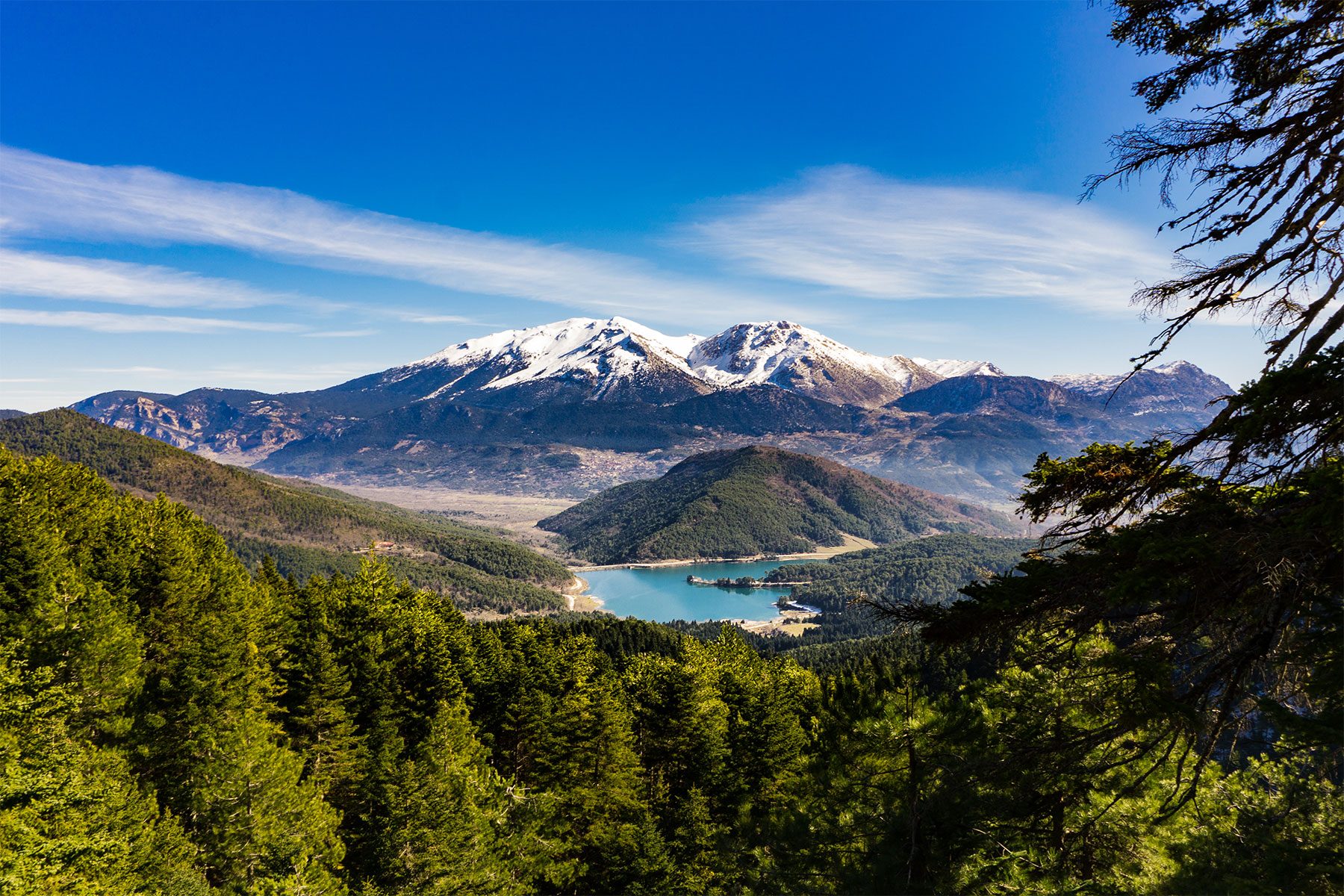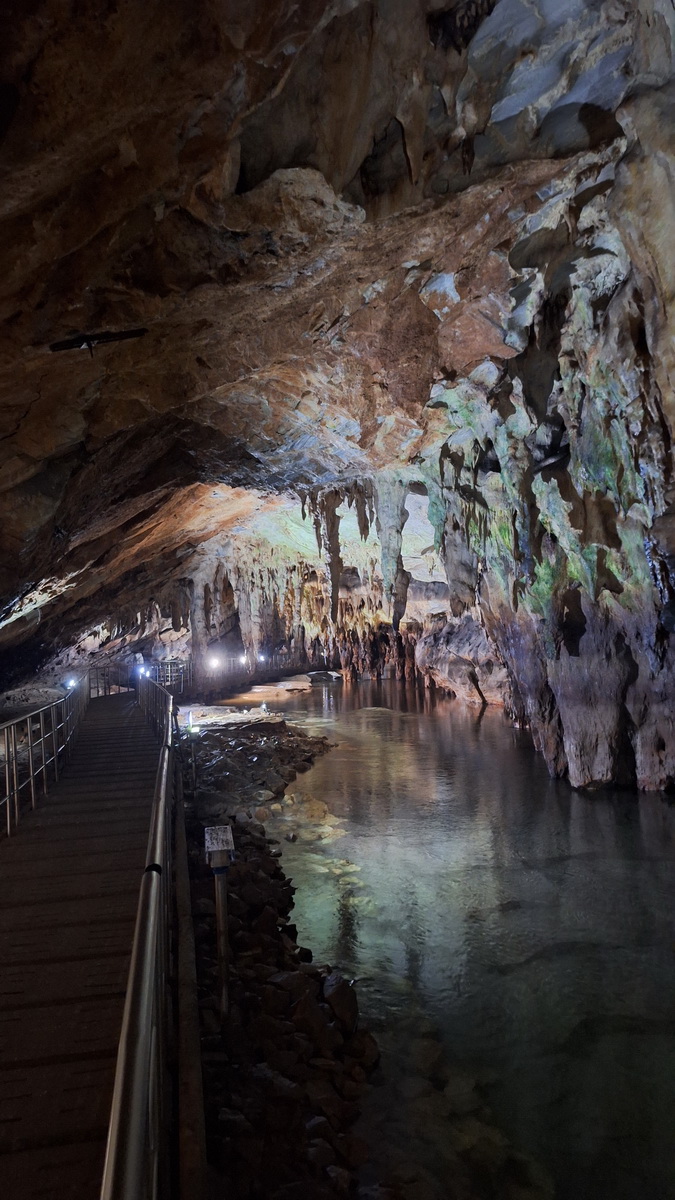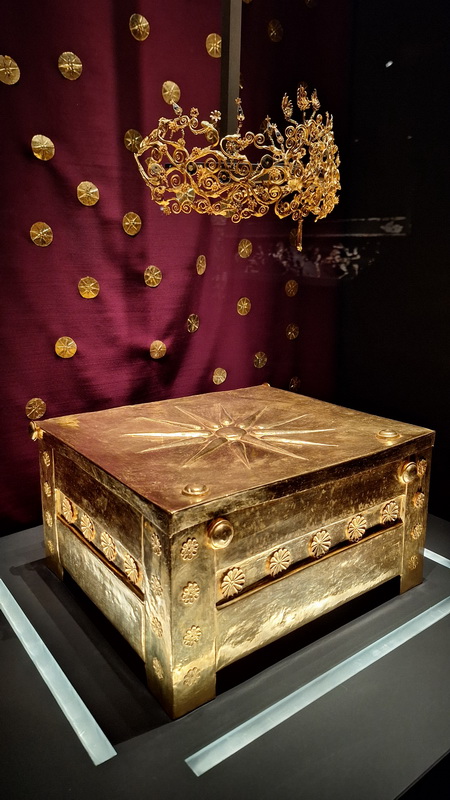

- Home
- Kastoria, A City With A Rich History Through The Centuries
- Posts
- Kastoria, A City With A Rich History Through The Centuries
Home » Central Greece » Kastoria, A City With A Rich History Through The Centuries
Kastoria, a city with a rich history through the centuries
is today considered one of the most beautiful cities in Greece
and manages to maintain its traditional character intact.
According to tradition, it was founded by Orestes, in honor of Electra’s sister.
In Kastoria, important monuments of Byzantine culture are preserved to this day, such as the walls and the almost 80 Byzantine churches that it has, which together with the truly magnificent lake of Kastoria create an unsurpassed setting, which is difficult to resist even the most demanding traveler.
It flourished mainly during the 17th century, since then the old mansions can be seen, then the amazing mansions were built, which have combined the local character with the Byzantine architecture.
When you are in Kastoria, you should not miss to visit the Eco-Museum, the first in Greece, where the visitor has the opportunity to “see” digitally the Kastoria of the 6th century and get to know its diverse ecosystem.
You can also see the Folklore Museum, the Byzantine Museum as well as the Museum of Costume Design.
Also do not forget to visit the fossil forest, twenty million years old with tropical and subtropical plants, palm trunks and marine fossils. Be sure to visit the museum that houses many of the fossils.
You must also see Lake Orestiada, Agios Stefanos and the Byzantine castle, which is characterized by travelers of the time as inaccessible and fortified.
Necessary sights to see include the dragon cave, an impressive cave to visit with 7 underground lakes, 10 rooms and 5 corridors – tunnels, located on the north side of the city, near the chapel of Agios Nikolaos in the Monastery of Panagia Mavriotissa, 15 m. From the lakeside road. Its name is due to the tradition that says that inside there was a gold mine, which was guarded by a watchful dragon.
For those who love winter sports, in Vitsi, a village 20 km from the city of Kastoria, there is a ski center, with three slopes, which are able to receive a large number of visitors.
During your stay, do not hesitate to shop for some of the products it produces, which are also of excellent quality. Kastoria, of course, is mainly famous for the unique furs and leather it has and its agricultural products are a very good choice. So you will have the opportunity to buy delicious meat and cheese as well as legumes and nuts.
Kastoria seems to be a heavenly place that meets all tastes and requirements. In any category of tourists, whether you belong to nature lovers or if you are just looking for relaxation for two days.

Tour of the “Mansion” paths of Kastoria
In the neighborhoods of Apozari and Doltso, the Kastorian mansions built around the 17th and 18th centuries stand proudly and are the eyewitnesses of the economic prosperity of the Kastorian furriers, when their commercial activities had crossed the border with activities abroad.
The development of export trade with the countries of Central Europe created a class of rich bourgeois, who came into contact with Western culture. Aware of their power and given the strictly limited society in which they lived, they gave their homes such a form and dimensions as to enjoy their goods in an illusion of freedom.
The mansions of Kastoria are harmonized with the environment of the area, being samples of traditional architecture.
The mansions are basically two-storey. On the ground floor there are storage rooms, while in the yard there are auxiliary ones. On the middle floor are the winter residences and an inner wooden balcony. Upstairs, which is made of lighter materials and is widened with “sahnisia” (covered ledges), are the reception areas.
In many cases, depending on the slope of the ground, they are three-storey or four-storey, but they also have a garden, inner courtyard, are surrounded by a high fence, with closed balconies and windows protected by railings.
The ground floor and the mezzanine floor are made of stone with a few small openings, while the floors are made of lighter materials and have more windows.
The ground floor and basement areas are used for food storage and as work areas, on the mezzanine floor there are household items while the first floor was usually the fur workshop. The main space inside is a triple room (a space where there were “Π” (the Greek P letter) shaped entities around it). This space, with small modifications, was offered for many uses. The interior decoration was very careful with paintings on the walls, wood-carved ceilings and cabinets.
The mansions near the lake had courtyards up to its shore, in which they had the necessary boats to move them. Their construction was entrusted to Macedonian and Epirote craftsmen who were famous for their art abroad. They are distinguished mainly in three types with the first which is the oldest to have representative specimens of the mansions Tsiatsapa, Sapountzi, Basara and Emmanuel Brothers presenting a rectangular plan with domination of a single axis.
The second type with dominant specimens, the mansions Skoutari and Nerantzi Aivazi, in a square shape with a recess “Π” on one side. The third, who is also the youngest, presents a symmetrical plan in the shape of a cross on the floors and is found in the mansions of Papaterpou, Tzotza and Vergouleika.
Decoration of Kastoria mansions
The interior decoration is rich, with wood carvings, murals and skylights with colored glasses (vitraux). The wooden “ceilings” with the rhomboid or baklava decorations have in their center a circular or hexagonal rosette. Rarely are the ceilings plastered and have painted decoration as well as plaster carvings in the middle. The decoration of the walls is formed in two zones separated by a horizontal cornice (the “poulitsa”) at the height of the window sills and the interior doors.
The lower and larger part includes the internal and external openings as well as all the wooden surfaces (wall coverings and fitted wardrobes) with rich floral painting decoration. In the upper part between the skylights, painted surfaces with plant themes and baroque decorations are inserted. In addition, there are performances of fantastic landscapes and birds as well as cities and ports among which the performances of Istanbul stand out, depicted from the side of the Horn Bay. Lake Settlement of Dispilio, Kastoria, archeological site, Eco-Museum.
The archeological site of Dispilio and the EcoMuseum are located at a distance of 7 km from the city of Kastoria, on the south side of the lake. A lake settlement of the Late Neolithic Period has been excavated here, which developed around the lake, from the middle of the 6th to the middle of the 4th millennium BC.
With the creation of the Eco-Museum, which has been part of the “Life” program since 1966, and has been in operation since 2000, a faithful representation of the settlement was attempted, which enables the visitor to better approach the way of life of its inhabitants.
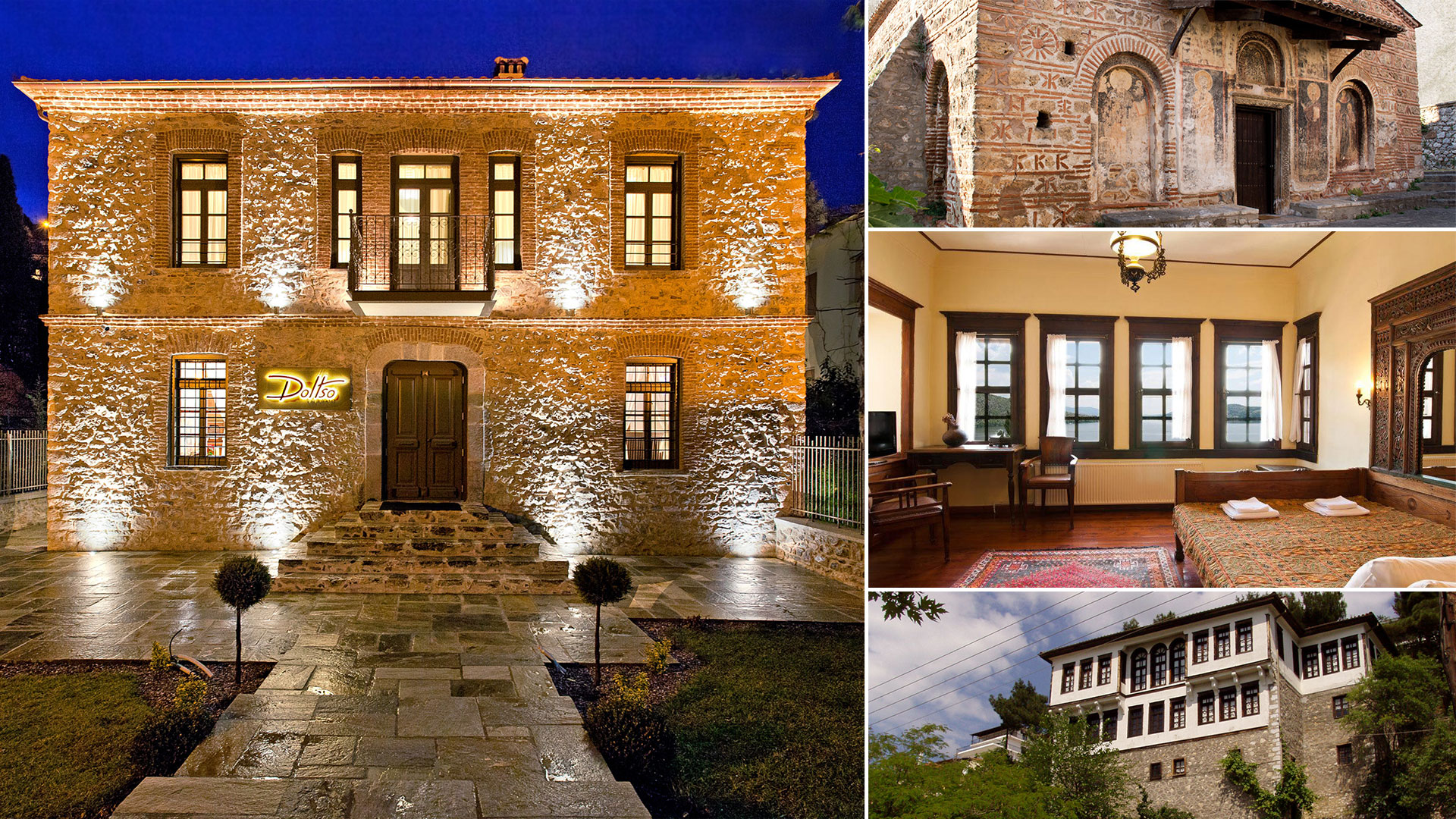
In the landscaped area there are huts on piled platforms, made in life size and materials similar to the originals.
Tree trunks were used for the frame, thin branches braided with rope for the walls, mud from the lake for the “plaster” and straw for the roofs.
Inside these dwellings of the Neolithic people of the lake, there are objects of daily use.
Clay pots, such as bottles, cups, fruit bowls and pots, flint or bone tools, baskets and a small fire, give a clear picture of the life and activities of the inhabitants
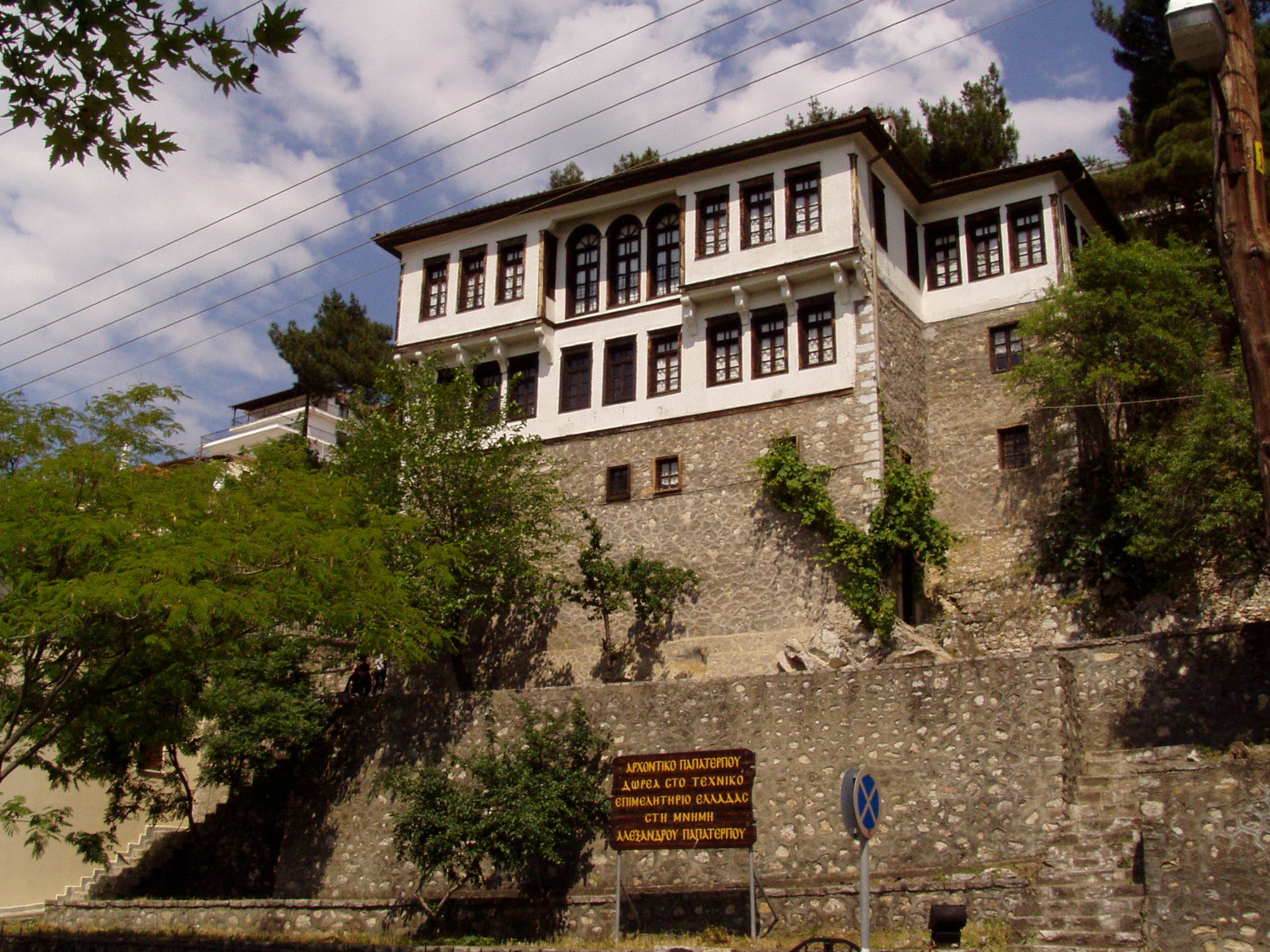
Folklore Museum of Kastoria. Nerantzi Aivazi Mansion
In one of the most picturesque streets of the city, is the mansion of Nerantzis Aivazis, which since 1975 houses the Folklore Museum of Kastoria. Here the material testimonies of the place, objects from the daily life at home and at work, objects related to ceremonies and celebrations find a hospitable home.
The visitor can tour the imposing “krevata” (bed), the place that hosted the official ceremonies and celebrations, the “kalon onta”, (good room) as well as the summer living room that now houses for the needs of the museum the representation of a fur workshop.
Nerantzi Aivazi Mansion
A short distance from the mansion Natzi and the mansion of the Emmanuel brothers at 12 Kapetan Lazou Street, is the mansion Nerantzi Aivazi which houses the Folklore Museum of the city.
The mansion was built in the late 18th century and until the mid-1960s belonged to the N. Aivazis family.
A special impression is made by the mural that adorns the interior of the building, with the theme of a nostalgic landscape of Istanbul.
The floor plan of the house is shaped like a “Π”, without the usual protrusions (“sahnisia”). The house has a ground floor, mezzanine and first floor.
On the mezzanine floor, the so-called “fur workshop” has the roof painted and the concave cornice under it, with buildings in landscape.
Floral motifs adorn the walls of the glory on the second floor as well as the walls of the “Kalon Onta”, (good room) which depicts “Venice in the painter’s imagination”.
The house was painted for the most part, but when the owners whitewashed the walls, on the advice of doctors, to prevent tuberculosis, many of the decorations were lost. In the shed of the mansion are the kneader, the food cellar and the wine cellar.
It belongs to the Municipality of Kastoria and is supervised by the Musicological Association “Armonia”
The rich decoration of the glory, the warm cozy rooms, the old photos, the good being, the shop where the fur clippings were sewn with the needle, as well as the basement supplies, transport the visitor mentally to the past, offering many elements of culture and the prosperity of the inhabitants of Kastoria.
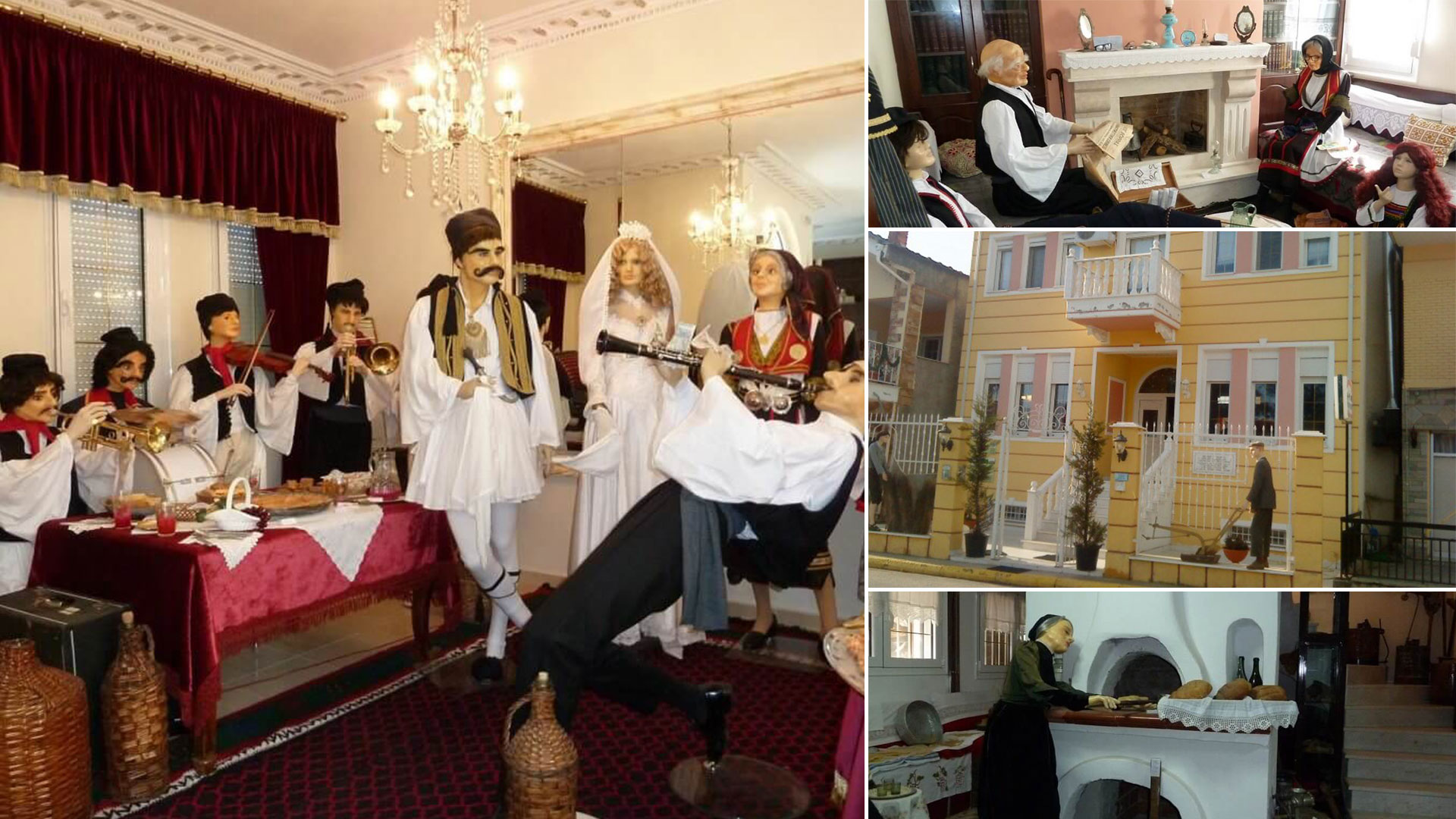
Lake Kastoria – Orestiada. Short and big tour of the lake.
The lake of Kastoria, one of the most beautiful in the Balkans, is directly connected with the physiognomy, history and evolution of the city. It has been designated as a “Monument of Natural Beauty” by the Ministry of Culture and has been included in the European Network “Nature 2000”.Its area is about 28 square kilometers and its maximum depth is about 9.5 meters. In the area there are nine streams that end in the lake. The largest of these is the stream of Xiropotamos.
In addition to streams and rainwater, Lake Orestiada is supplied by many lakeside springs. It is a wetland of great importance for aquatic animals, but also for birds of prey and serves as a breeding, feeding and wintering area.It conserves a rich bird fauna – about 200 species – which includes rare and endangered species, protected by international and national law.
The most characteristic of these are the halibut and the silver pelican, four species of herons, the mute swans, the mallards, the night crows, the cormorants and many waterfowl.
Apart from the large number of birds it hosts, it is the only lake in Greece, in which there are significant riparian forests of hydrophilic trees, which constitute one of the rarest habitats in Europe.
Lake Kastoria is the second most productive lake in Greece. The species of fish that exist in the lake are the carp (Grivadi), the perch, the tsironi, the glini, the gulianos, the tourna, the platika the priki and the butterfly.
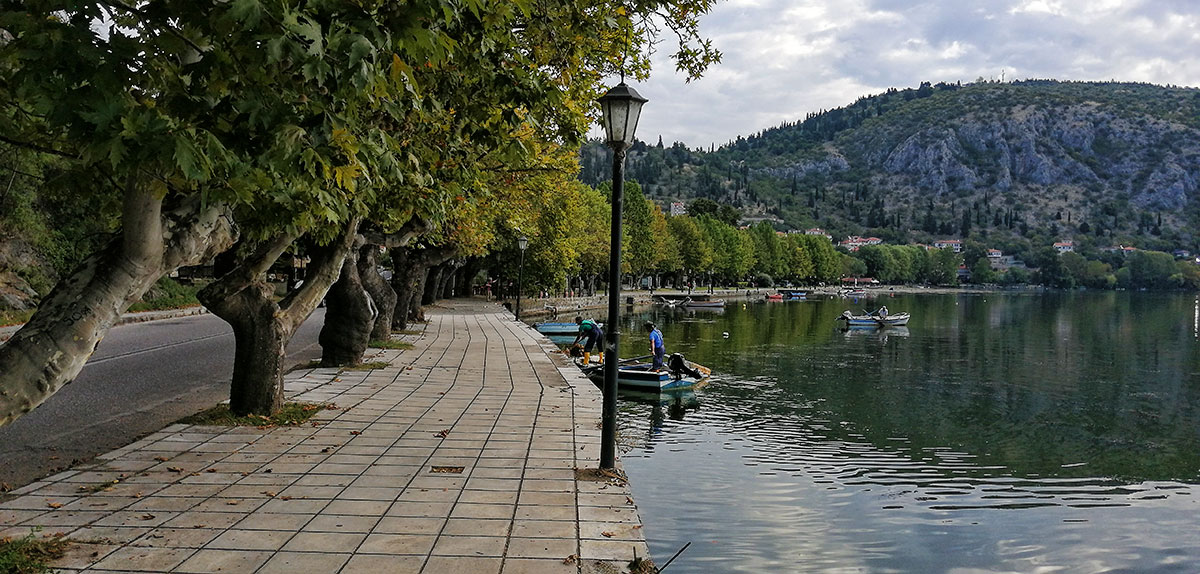
The short tour of the lake
This walk is ideal for those who want to enjoy the lake up close. The best way to enjoy the scenery is to do it on foot or by bike. Leaving the two-way road that passes through Doltso, the passer-by has in front of him 7 idyllic kilometers right next to the lake.
The lakeside road is paved but very narrow. The plane trees and willows lean over the lake. At the beginning of this route, perched on the rock, is the Byzantine church of Agios Nikolaos.
On the road you can meet walkers and groups of people fishing with rods. Nice pictures that show the constantly renewed relationship of people with the lake.
On the plateau in front of the Monastery of Panagia Mavriotissa stands a plane tree about 900 years old, which has been designated a protected natural monument. Adjacent vendors sell their products (legumes, nuts, pickles, tea) to passers-by. The visit to the monastery leaves a sense of housekeeping and humility. The frescoes of the 12th century are located inside and outside the walls of the katholikon, as well as in the chapel of Agios Ioannis Theologos. The forms of the hagiographies, illuminated by the dim light of the candles and the reflection of the fire of the stove, acquire another dimension.
The road continues with the same dense vegetation at its edge and with kiosks, ideal for picnics. The blue signs of the amateur fishermen’s association warn every now and then “Fishing without being illegal, friend amateur fisherman”. The silence is often interrupted by bird diving and flying in the reeds. Ducks, pelicans, herons, cormorants find plenty of food in the lake. Few fishermen spread their nets with boats, with “karavia”, as the people of Kastoria call them. They paddle upright, pushing the oars with their body weight. These boats on the lakes are long and narrow, with very raised ends, a sloping bottom and long oars. Although they have a heavy body, they are flexible and fast.
Another type of boat is the single pole, which is small and is used for shallow fishing. It is impressive that in the Neolithic lake settlement of Dispilio such a boat was discovered, made of one-piece logs.
After the post-Byzantine church of the Transfiguration of the Savior, located on the hill we reach the end of the lakeside road, where the building of the Nautical Club is located. Unique view of the lake from this point.
The Nautical Club is active with great success in rowing. From this point you can often see children playing on the pier or rowing in the lake.
The walk continues to the Tsiatsiapa mansion, a beautiful mansion built in 1754 and completed at the top of Agios Athanasios, in Tsardaki
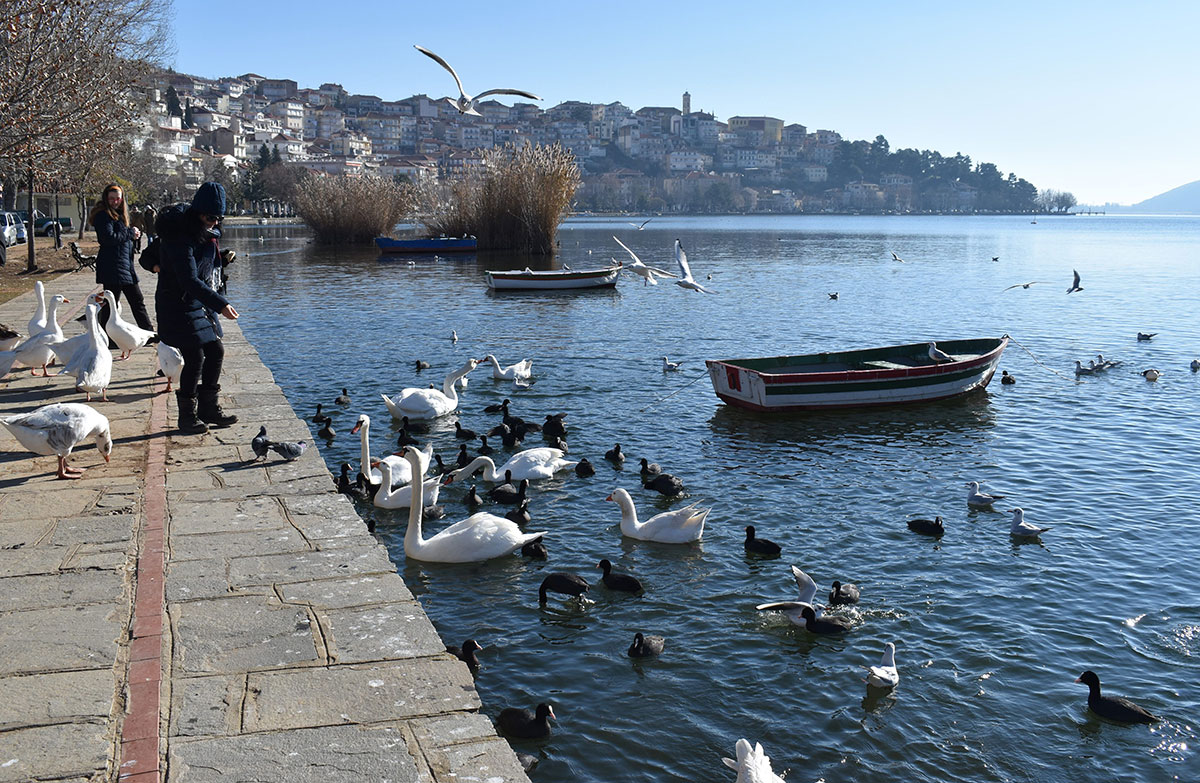
The big tour of the lake
This route gives the traveler the opportunity to see the lake in all its glory. Starting from the southern exit of the city and driving parallel to the lake, you reach Dispilio which is located at a distance of 7 km from Kastoria. At Douchlo there is an interesting cave, which is accessed by stairs.
The bridges of the village of Giole, Cesme, Lacos and Granovoda are interesting architectures of traditional architecture. Near the church of the Ascension, in Nisi, the important lake settlement of Dispilio has been excavated since 1992.
Continuing after Dispilio at 5 km, the road passes through the settlement of Krepeni. From here, according to tradition, the element of Krepeni started to go to Kastoria to enter the houses of the housewives and to make his messes.
A visit to the church of Agios Nikolaos, located outside Mavrochori, is worth it. This church, of the 16th century, is the only remnant of the monastery that existed here. Magnificent paintings of the 18th century adorn the outer wall of the narthex and among them the excellent depiction of the slaughter of infants.
The beach of Mavrochori, the “mouragio”, offers a wonderful view of the lake. The pier is beautiful, with landscaped green spaces and plane trees. Here you can try local delicacies, such as sarmades (cabbage stuffing with sauerkraut), carp and black noodles. From Mavrochori starts a tourist boat that goes around the lake.
Driving north and parallel to the lake we reach Polykarpi which is 1 km from Mavrochori and 14 km from the city. The village is suitable for lakeside hiking, as well as for nice walks in the plain where there are apple orchards.
Continuing and turning from the main road we are in two villages that offer panoramic views of Kastoria. In Fotini stands out the oak forest, called “Kaniakos” and covers an area of 4,000 acres. The oak and beech forest “Kouri”, located in Metamorfosi offers excellent views. Outside the village there is in a very beautiful location the church of the Transfiguration of the Savior, of the 8th century. Then we meet the Wall. The tour of the lake is completed with the entrance to the city from the beautiful suburb Chloe.

Museum of Wax Figures of Folklore and Prehistory
This new museum was founded in Mavrochori, Kastoria, by the couple Panagiotidis Dimitris and Theocharis Theofano. In two buildings of local architecture, scenes of daily life of our people are presented, reviving customs and traditions nationwide.
An entire pre-war village has also been created with life-size shops and houses where visitors can see the old forgotten professions – carpenter, glazier, shoemaker, blacksmith, etc. In a cave an entire tribe of Archangels process leather, weapons, cooking utensils, tools, in a difficult struggle for survival. The various exhibits are divided into thematic units so that visitors – especially students – can be easily and methodically taught the evolution of our culture from ancient times to modern times.
Circle of bread, wool, vintage, kitchen utensils, fire, uniforms, weapons, musical instruments, etc. At the same time, it operates as a cultural center with various activities such as theater – music – literary evenings – exhibitions of works by artists, library, etc. The life-size wax figures represent simple graphic types of all ages, of the village and the city at work and toil in period costumes. Antiques are authentic pieces and countless!
In the same space is co-located the collection of Mr. Pistikos with exact miniatures of the main mansions, Byzantine churches and monuments of the Prefecture.
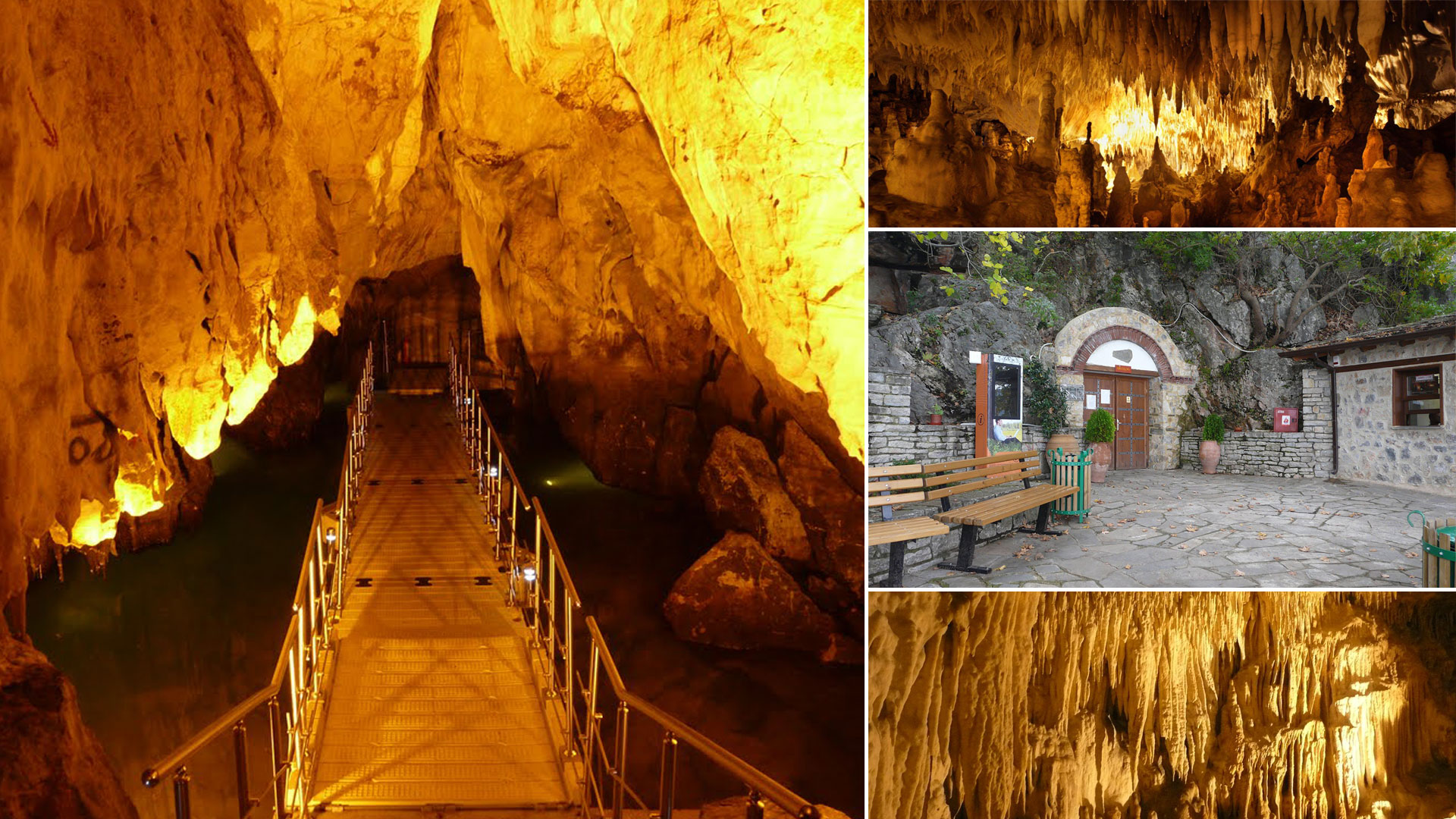
Dragon Cave and The myth of the cave
Many centuries ago, the large cave in front of the monastery of Mavriotissa was a gold mine guarded by a dragon that breathed and released flames and poisonous fumes from its mouth. The monster after a battle, was beaten and floated dead in the waters of the lake. Then, with lighted torches, people proceeded to the cave where at some point the torches went out due to lack of oxygen at the bottom of the cave.
Then a voice was heard saying, “He who bends down and takes a handful of mud will repent, but he who does not take it again will repent”.
Some dared to take mud from the cave and coming out in the sunlight they were surprised to see that they were holding wet gold dust.
Location – Description
The cave is located on the north side of the city at the 2nd km of the lakeside road Sougaridis, in the areas where the rocky mountains meet the shores of the lake and just before the Monastery of Panagia Mavriotissa.
It was discovered in 1954, 15 meters from the lakeside road and in 1968 the cave was mapped. The entrance is about twenty (20) meters from the shores of the lake and is closed with a door installed by the Municipality of Kastoria.
Inside there are large land and lake sections with impressive dripping decoration as it includes seven (7) underground lakes, ten (10) rooms, five (5) corridors – tunnels. The largest room of the cave has dimensions of 45×17 meters with its central part elevated and its sides ending in lakes. The large lake of the cave which is the deepest is located west. The temperature inside the Cave is constant in all seasons at 16-18Oc, while the humidity reaches 90%.
In the Cave of the Dragon, which is one of the most impressive utilized in Greece, no traces of human presence have been found, but bear bones of the caves are 10,000 years old. The bear cave is one of the largest bears that have lived with a weight that could reach half a ton and a height of more than 2.5 meters in an upright position.
It is essential that all necessary measures have been taken for the safety of the visitors and the interventions inside were done in such a way as not to affect the physical condition of the Cave.
Visitable route
It has a length of 300 meters of natural route while the exit of the visitor is done through a technical tunnel of 35m. The natural beauty of the route comes from the rich stalactite and stalagmite decoration. On the way the visitor passes beautiful constructed bridges, 2 solid and 1 floating.
The exit is made through a technical tunnel that also functions as a museum space that through photographic material is informed about the history, the myth, the phases of construction – utilization as well as information about the caves throughout Greece (geomorphology position within a to raise awareness of visitors to the “monuments of nature” that are the caves.
Opening hours:
Tuesday to Sunday
Summer Hours: 10.00 – 18.00
Winter Hours: 09.00 – 17.00
Closed on Monday
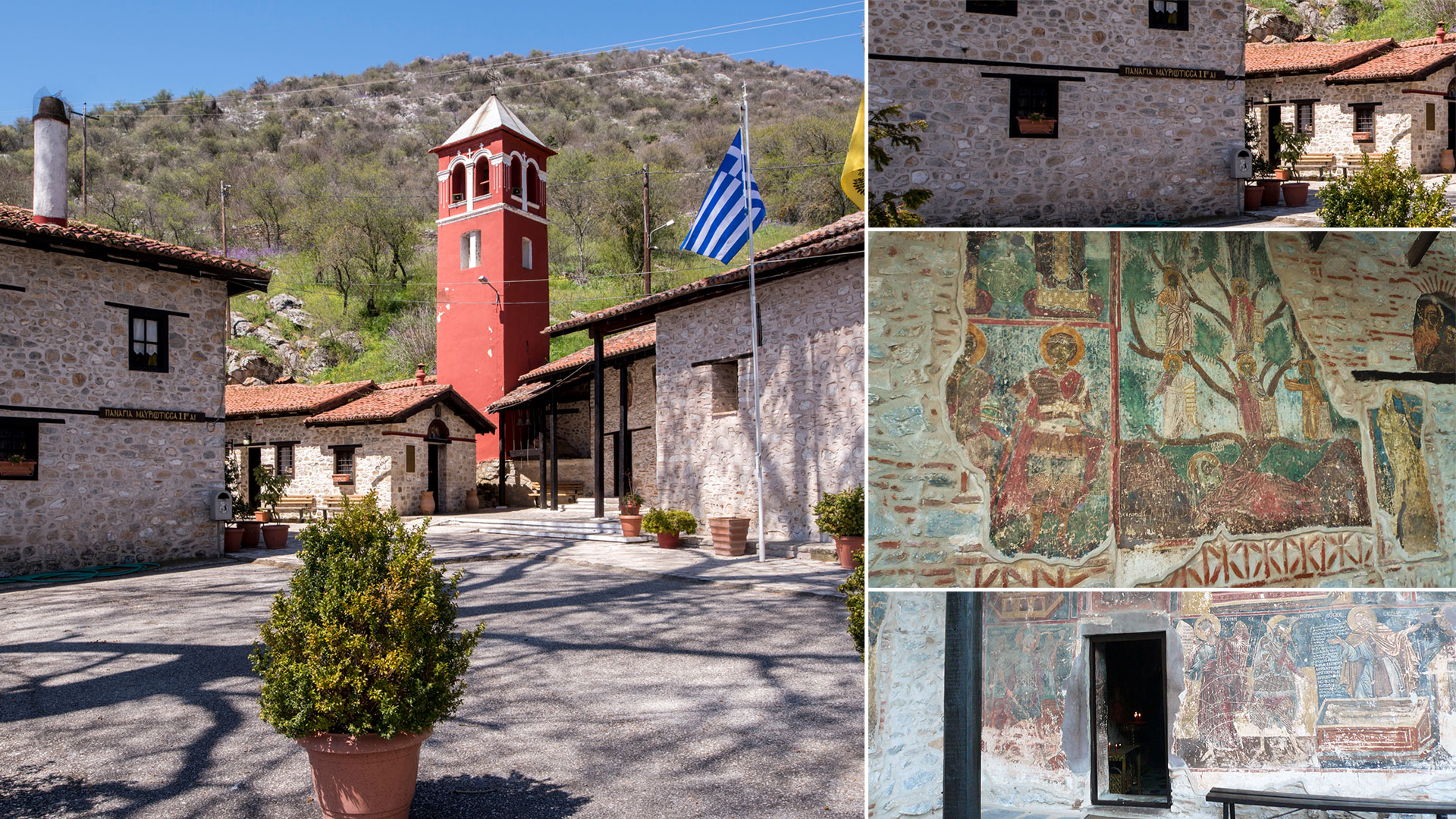
Monastery of Panagia Mavriotissa
Built in 1082 during the reign of the Byzantine Emperor Alexios A’ Komnenos, this Byzantine treasure is located four kilometers from the center of Kastoria, next to the lake.
The katholikon of the monastery belongs to the category of single-room, wooden-roofed basilicas. To the east of the temple the arch is semicircular, while to the west a spacious narthex is formed.
The frescoes on the east wall of the monastery are placed in the first half of the 12th century and the representation of the Second Coming on the east and south walls of the narthex is at the end.
The exterior frescoes, depicting Emperors and Saints Demetrius and George, are placed around 1260. Over the centuries, various repairs have been made to the building resulting in the destruction of much of the hagiography.
The painted decoration was preserved on the east and west wall of the main church and on the east and south wall of the narthex. Other exterior frescoes are preserved on the open porch, in front of the entrance to the katholikon.
The painting of the katholikon belongs to different periods. In part of the east wall there are representations dating to the first half of the 12th century, while in another part of the same wall and throughout the west there are representations from the end of the 12th century. The large representation of the Second Coming, which takes place on the east and south walls of the narthex, is extremely interesting from an iconographic point of view and is estimated to belong to the end of the 12th century. The scene of the Baptism, pictured below, is perhaps a little later. The external frescoes (iesse root, emperors and Saints Demetrios and George) are placed around 1260.
The monastery of Mavriotissa played an important role as a spiritual space in all phases of the history of Kastoria. This explains the special interest shown to her by Byzantine officials. The artistic workshop that undertook the decoration of the monument was directly related to the capital of the Byzantine state in Constantinople.
Recently, a rare engraved plaque-typographic matrix representing the Assumption of the Virgin Mary returned to the monastery. With this plaque the monks printed engravings. It was built in 1749 in Vienna on behalf of the monastery, at the expense of the Kastorian Manuel Tsiatlampasis.
In the area of the monastery there are other later buildings, the museum and a chapel in memory of St. John the Theologian.

The Carnival of Kastoria – Ragoutsaria
The fun and spree of the Kastorian carnival is now known to everyone.
The Ragoutsaria, as the carnivals are called, are celebrated from the 6th to the 8th of January and are a revival of the ancient Dionysian ceremonies, which took place from ancient times and according to the locals is a celebration that aims to forget the problems of the year.
The carnival events are the culmination of the festivities for the city, because they are combined with the festivities of the twelve days. In Ragoutsaria all the people of Kastoria take part, but also many foreigners who are present in those days in the city and all pour into the streets and alleys, celebrating with dances, songs, teasing and with plenty of wine.
Many orchestras with brass instruments, consisting of 5 to 12 people, also take part.
If you are in Kastoria during the events you will feel what a spree it will say and surely the whole process will not leave you indifferent.
The origin of the name
The name Ragoutsaria comes from the Latin rogatores, meaning beggars (still rogatio in Latin means ask), since the disguised ones ask the housewives to give them gifts in order to ward off evil spirits.
Disguises
In ancient times, people disguised themselves as animals such as cows, deer and goats, during the Byzantine period this disguise was strictly forbidden, and so gradually other forms of disguise were introduced, such as e.g. gender reassignment (men wear skirts and scarves and women mustaches and ties).
However, until 1930, the figure of Bacchus dominated the ragoutsaria.
In addition to the symbolic interpretations of the custom, the Kastorian Ragoutsaria today give a cheerful and fun note, attracting many visitors for a frantic party beyond the ordinary.
History
The Ragoutsaria originate from the ancient Winter Dionysians, and are known by this name only in Macedonia and Thessaly, where there was a troupe of disguises who went from house to house, entering and greeting the housewives asking for treats and tips. They were hidden behind sheepskin and makeshift masks, taking care to remove the evil spirits that plagued the world of those times.
During Roman rule, disguises continued and new festivities were added. The Rogatores (beggars), during their visit to the houses of the area, took treats and tips, expelling the evil spirits that made people’s lives difficult.
In Byzantine times, the worship festivals of Ancient Greece came into conflict with the official Christian Religion and many elements were lost or completely forgotten. However, many of them managed and withstood the time and obstacles, reaching to the present day.
During the Turkish occupation, they managed to cross the threshold of the 20th century as “tsaraniasmenoi ragoutsarides” (those painted black on the face and body). Residents took to the streets in disguise, visiting homes, especially those celebrating, and necessarily arriving at the square in Doltso. Teasing, tips and sweets were essential throughout the scene.
Until the 1920s and 1930s, the presence of Bacchus was necessary, accompanied by a donkey adorned with vines and resting on his saddle the steak of the god Dionysus, in which there was a small barrel of wine.
During the 1940s-50s and the return of many Kastorians from abroad, new changes in disguise began to appear.
The big and well-known cafes “Aigli” and “Byzantio” organized all-night parties, with groups of disguised people, some of whom were disguised according to traditional customs, while others began to adopt new ways and models of disguise.
In the middle of the decade, the awarding of the disguised by the Municipality of Kastoria began, giving another dimension to the whole process.
The Ragoutsaria today
The beginning of the carnival takes place on the Epiphany, after the throwing of the cross and the sanctification of the waters. Focusing on Mitropoleos Street and Omonia Square, the disguised people come and go dancing and having fun.
On the second day, on the day of Ai Gianni, each group goes home (as has been the case for a long time), to ward off evil spirits and to encourage housewives to participate in the frantic feast.
On the third day, the events culminate with the big parade (pateritsa) of the chariots and the disguises (bouloukia and school groups), starting from the City Hall, reaching Omonia Square, after passing Mitropoleos Street and ending at Doltso Square. During the parade, which lasts several hours, schools and groups take part in the parade on foot and with the accompaniment of instruments. Then the best entries in the various categories (appearance, spectacle, satire, tradition) are awarded with the delivery of souvenirs.
In the heart of winter and during the last hours of the twelve days, the city of Kastoria surrenders to a unique three-day feast of joy and spree, which is spontaneously born in the countless groups of young and old who take part. On the 6th, 7th and 8th of January, the halls and the nightclubs are full of people, having fun and taking care to maintain the customs and traditions of the area.
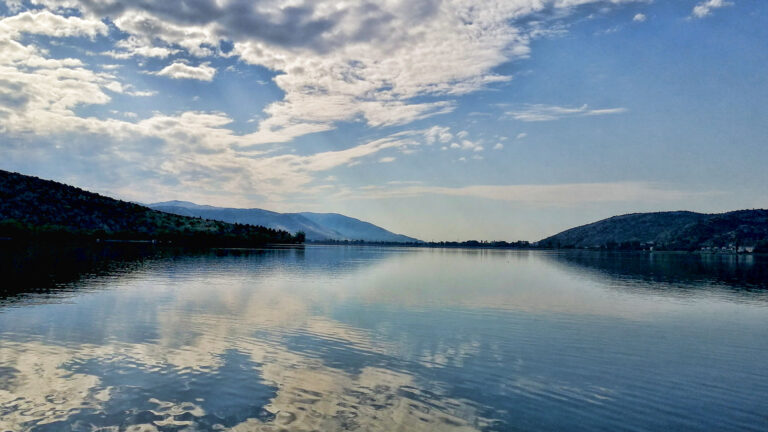
Why Kastoria?
Because is one of the most beautiful cities in Greece!
Beautiful landscapes, Nice people, Hospitality, Experiences that are completed with the smiles of the locals, Crystal clear blue water, Countless islands, Green mountains! And these are just a few of the many things you can enjoy in Greece!
We love this Greece, we support this Greece, We love to introduce you Greece, We love to help you explore Greece!
what our clients say about us

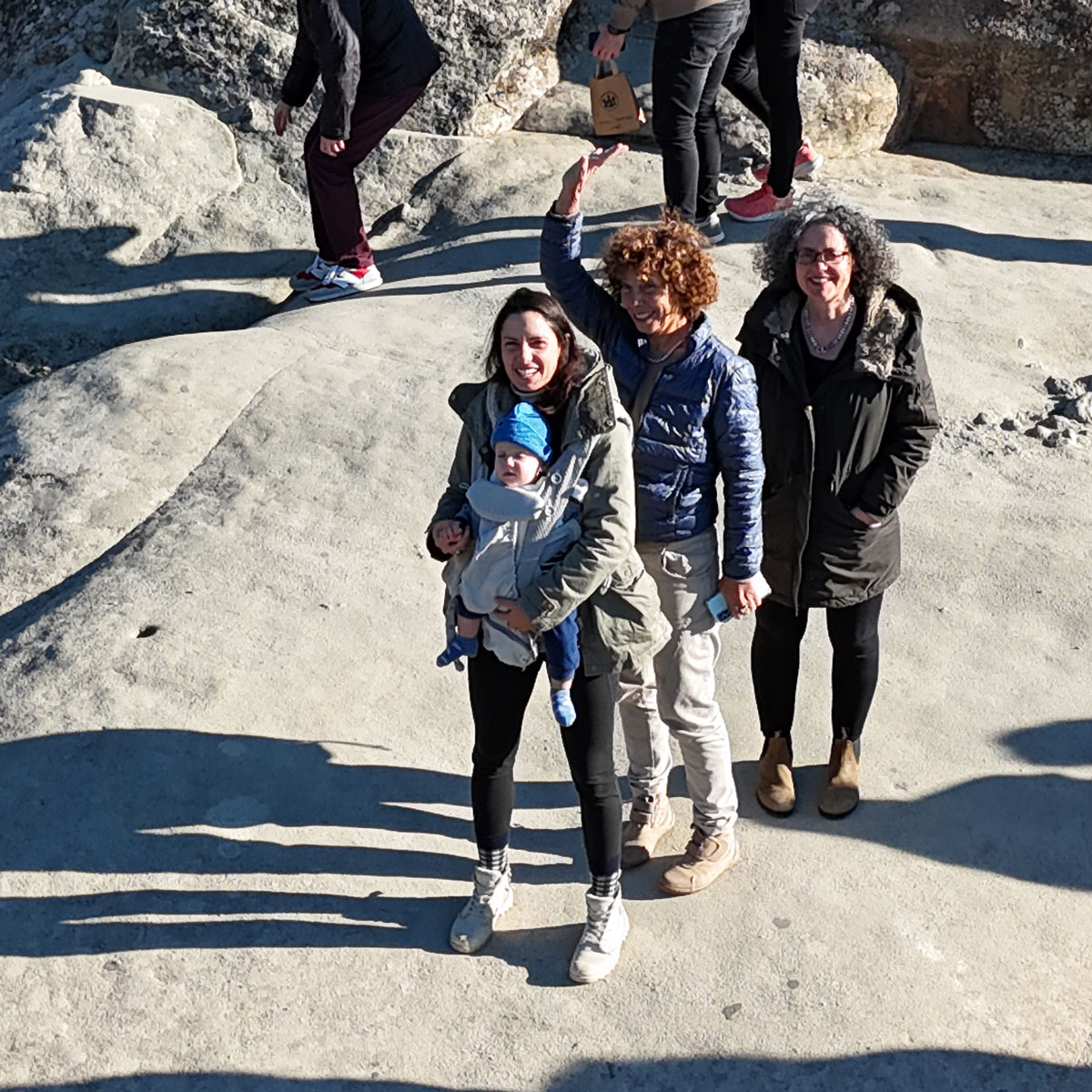

Share The Post
Kastoria, a city with a rich history through the centuries, is today considered one of the most beautiful cities in Greece and manages to maintain its traditional character intact.
According to tradition, it was founded by Orestes, in honor of Electra’s sister.
In Kastoria, important monuments of Byzantine culture are preserved to this day, such as the walls and the almost 80 Byzantine churches that it has, which together with the truly magnificent lake of Kastoria create an unsurpassed setting, which is difficult to resist even the most demanding traveler.
It flourished mainly during the 17th century, since then the old mansions can be seen, then the amazing mansions were built, which have combined the local character with the Byzantine architecture.
When you are in Kastoria, you should not miss to visit the Eco-Museum, the first in Greece, where the visitor has the opportunity to “see” digitally the Kastoria of the 6th century and get to know its diverse ecosystem.
You can also see the Folklore Museum, the Byzantine Museum as well as the Museum of Costume Design.
Also do not forget to visit the fossil forest, twenty million years old with tropical and subtropical plants, palm trunks and marine fossils. Be sure to visit the museum that houses many of the fossils.
You must also see Lake Orestiada, Agios Stefanos and the Byzantine castle, which is characterized by travelers of the time as inaccessible and fortified.
Necessary sights to see include the dragon cave, an impressive cave to visit with 7 underground lakes, 10 rooms and 5 corridors – tunnels, located on the north side of the city, near the chapel of Agios Nikolaos in the Monastery of Panagia Mavriotissa, 15 m. From the lakeside road. Its name is due to the tradition that says that inside there was a gold mine, which was guarded by a watchful dragon.
For those who love winter sports, in Vitsi, a village 20 km from the city of Kastoria, there is a ski center, with three slopes, which are able to receive a large number of visitors.
During your stay, do not hesitate to shop for some of the products it produces, which are also of excellent quality. Kastoria, of course, is mainly famous for the unique furs and leather it has and its agricultural products are a very good choice. So you will have the opportunity to buy delicious meat and cheese as well as legumes and nuts.
Kastoria seems to be a heavenly place that meets all tastes and requirements. In any category of tourists, whether you belong to nature lovers or if you are just looking for relaxation for two days.
Tour of the “Mansion” paths of Kastoria
In the neighborhoods of Apozari and Doltso, the Kastorian mansions built around the 17th and 18th centuries stand proudly and are the eyewitnesses of the economic prosperity of the Kastorian furriers, when their commercial activities had crossed the border with activities abroad.
The development of export trade with the countries of Central Europe created a class of rich bourgeois, who came into contact with Western culture. Aware of their power and given the strictly limited society in which they lived, they gave their homes such a form and dimensions as to enjoy their goods in an illusion of freedom.
The mansions of Kastoria are harmonized with the environment of the area, being samples of traditional architecture.
The mansions are basically two-storey. On the ground floor there are storage rooms, while in the yard there are auxiliary ones. On the middle floor are the winter residences and an inner wooden balcony. Upstairs, which is made of lighter materials and is widened with “sahnisia” (covered ledges), are the reception areas.
In many cases, depending on the slope of the ground, they are three-storey or four-storey, but they also have a garden, inner courtyard, are surrounded by a high fence, with closed balconies and windows protected by railings.
The ground floor and the mezzanine floor are made of stone with a few small openings, while the floors are made of lighter materials and have more windows.
The ground floor and basement areas are used for food storage and as work areas, on the mezzanine floor there are household items while the first floor was usually the fur workshop.
The main space inside is a triple room (a space where there were “Π” shaped entities around it).
This space, with small modifications, was offered for many uses.
The interior decoration was very careful with paintings on the walls, wood-carved ceilings and cabinets.
The mansions near the lake had courtyards up to its shore, in which they had the necessary boats to move them.
Their construction was entrusted to Macedonian and Epirote craftsmen who were famous for their art abroad.
They are distinguished mainly in three types with the first which is the oldest to have representative specimens of the mansions Tsiatsapa, Sapountzi, Basara and Emmanuel Brothers presenting a rectangular plan with domination of a single axis.
The second type with dominant specimens, the mansions Skoutari and Nerantzi Aivazi, in a square shape with a recess “Π” on one side.
The third, who is also the youngest, presents a symmetrical plan in the shape of a cross on the floors and is found in the mansions of Papaterpou, Tzotza and Vergouleika.
Decoration of Kastoria mansions
The interior decoration is rich, with wood carvings, murals and skylights with colored glasses (vitraux).
The wooden “ceilings” with the rhomboid or baklava decorations have in their center a circular or hexagonal rosette.
Rarely are the ceilings plastered and have painted decoration as well as plaster carvings in the middle. The decoration of the walls is formed in two zones separated by a horizontal cornice (the “poulitsa”) at the height of the window sills and the interior doors.
The lower and larger part includes the internal and external openings as well as all the wooden surfaces (wall coverings and fitted wardrobes) with rich floral painting decoration.
In the upper part between the skylights, painted surfaces with plant themes and baroque decorations are inserted.
In addition, there are performances of fantastic landscapes and birds as well as cities and ports among which the performances of Istanbul stand out, depicted from the side of the Horn Bay.
